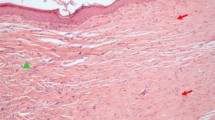Summary
In maintaining the rat, the collagen dressings, Aviderm Amine and Aviderm, are as effective as skin in low bacterial levels in contaminated surgical wounds. In the scald-burn wound in the rat the effect of skin dressing is confirmed. Also, 48 h after collagen dressing in the wound the bacterial contamination was the same as that seen under autograft dressings.
We have elsewhere suggested that skin and some other dressings modify the local host defense by their effect on the accumulated white blood cells. We believe that collagen, as well as some synthetics, can alter the local environment permitting the destruction of invading bacteria by the accumulated white blood cells.
Zusammenfassung
Eigenhaut-, Fremdhaut- und Tierhauttransplantate können die bakterielle Besiedlungsdichte infizierter Wunden (wie z. B. nach Verbrennungen) herabsetzen.
Diese Beobachtungen dienten als Grundlage obenangeführter Untersuchungen.
Auf einen ca. 2 x 2 cm messenden Hautdefekt bei der Ratte wurden 107 Pseudomonas aeruginosa-Keime aufgetropft. Der infizierte Bezirk blieb entweder unbedeckt oder wurde mit Eigenhaut bzw. mit einer eigens präparierten lyophilisierten Ochsenhaut abgedeckt. 48 h danach wurde aus dem infizierten Unterhautgewebe (musculus panniculus) Gewebsproben zur Bestimmung des bakteriellen Infektionsgrades entnommen. Dieser war bei der mit Eigenhaut sowie bei der mit lyophilitisierten Ochsenhaut signifikant geringer als bei der unbedeckten Wunde.
Similar content being viewed by others
References
Bell, C. C., Jr., Haynes, B. W., Jr., Hume, D. M. et al.: Clinical and experimental studies in fetal skin homografting. Surg. Forum10, 857–860 (1960)
Blocker, T. G., Jr., Bass, J. A., Lewis, S. R., et al.: General aspects of microbial growth in the burn wound. Amer. J. Surg.95, 309–311 (1958)
Blocker, T. G., Jr., Lewis, S. R., Jacobson, J. S., et al.: Bacterial contamination and infection in the severely burned patient. Tex. State J. Med.55, 358–360 (1959)
Boswick, M. D., Stone, N. H.: Profiles of burn management IV care of the burn wound. Ind. med. Surg.37, 823–831 (1968)
Brown, J. B., Fryer, M. P., Randall, P., et al.: Postmortem homografts as “biological” dressings for extensive burns and denuded areas. Ann. Surg.138, 618–630 (1953)
Eade, G. G.: The relationship between granulation tissue, bacteria and skin grafts in burned patients. Plast reconstr. Surg.22, 42–45 (1958)
Hait, M. R., Battista, O. A., Stark, R. B., et al.: Microcrystalline collagen as a biologic dressing, vascular prothesis and hemostatic agent. Surg. Forum20, 51–53 (1969)
Hedberg, M.: Acetamide agar medium selective for Pseudomonas aeruginosa. Appl. Microbiol.17, 481–482 (1969)
MacMillan, B. G.: Homocraft skin-a valuable adjunct to the treatment of thermal burns. J. Trauma12, 130–141 (1962)
O'Neil, J. A., Jr., Grosfeld, J. L., Boles, T. E., Jr.: The extended use of skin homografts. Arch. Surg.99, 263–268 (1969)
Pigeon, J.: Treatment of second-degree bums with amniotic membranes. Canad. med. Ass. J.83, 844–845 (1960)
Rappaport, I. A., Pepino, T., Dietrick, W.: Early use of xenografts as biologic dressings in burn trauma. Amer. J. Surg.120, 144–148 (1970)
Saymen, D. G., Nathan, P., Holder, I. A., et al.: Control of surface wound infection: skin versus synthetic grafts. Appl. Microbiol.25, 921–934 (1973)
Saymen, D. G., Nathan, P., Holder, I. A., et al.: Infected surface wound: an experimental model and method for the quantitation of bacteria in infected tissues. Appl. Microbiol.23, 509–514 (1972)
Sewell, W. H., Koth, D. R., Pate, J. W., et al.: Review of some experiments with freeze-dried grafts. Amer. J. Surg.91, 358–361 (1956)
Sneve, J.: The treatment of burns and skin grafting. J. Amer. med. Ass.45, 1–8 (1905)
Song, I. C., Bromberg, E., Koehnlein, E., et al.: Pig skin and bovine collagen as possible temporary dressings for skin wounds. Surg. Forum14, 466–468 (1963)
Stone, N. H., Boswick, J. A., Johnson, H. A.: Profiles of burn management V complications associated with burns. Industr. Med. Surg.37, 903–912 (1968)
Switzer, W. E., Moncrief, J. A., Mills, W., Jr., et al.: The use of canine heterografts in the therapy of thermal injury. J. Trauma6, 391–398 (1966)
Author information
Authors and Affiliations
Additional information
Herrn Professor Dr. M. Schwaiger zum 65. Geburtstag gewidmet
Rights and permissions
About this article
Cite this article
Burget, A., Nathan, P., Holder, I.A. et al. The effect of a collagen dressing on contaminated surgical wounds in rats. Langenbecks Arch Chiv 343, 69–73 (1976). https://doi.org/10.1007/BF01261571
Received:
Issue Date:
DOI: https://doi.org/10.1007/BF01261571




